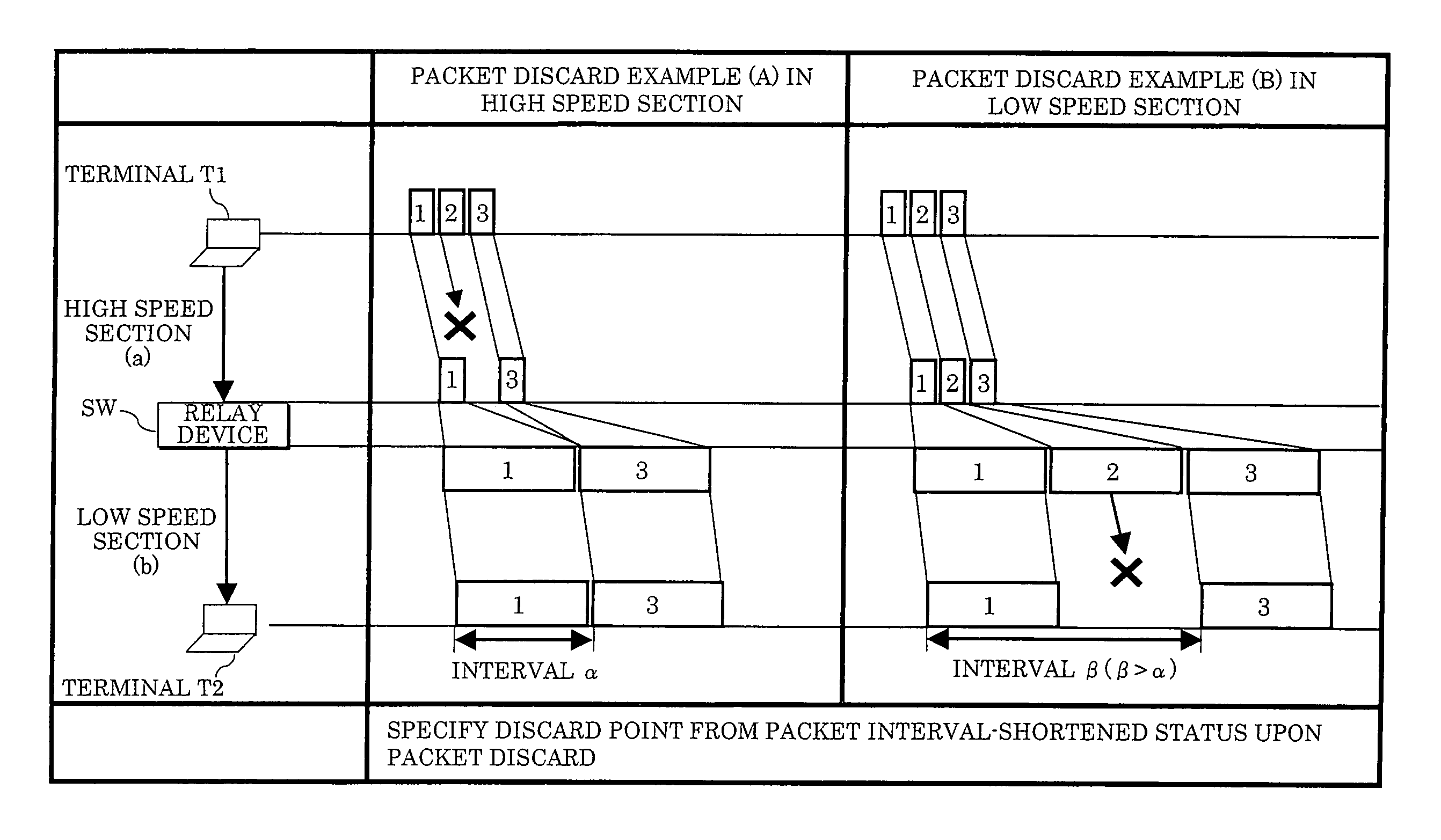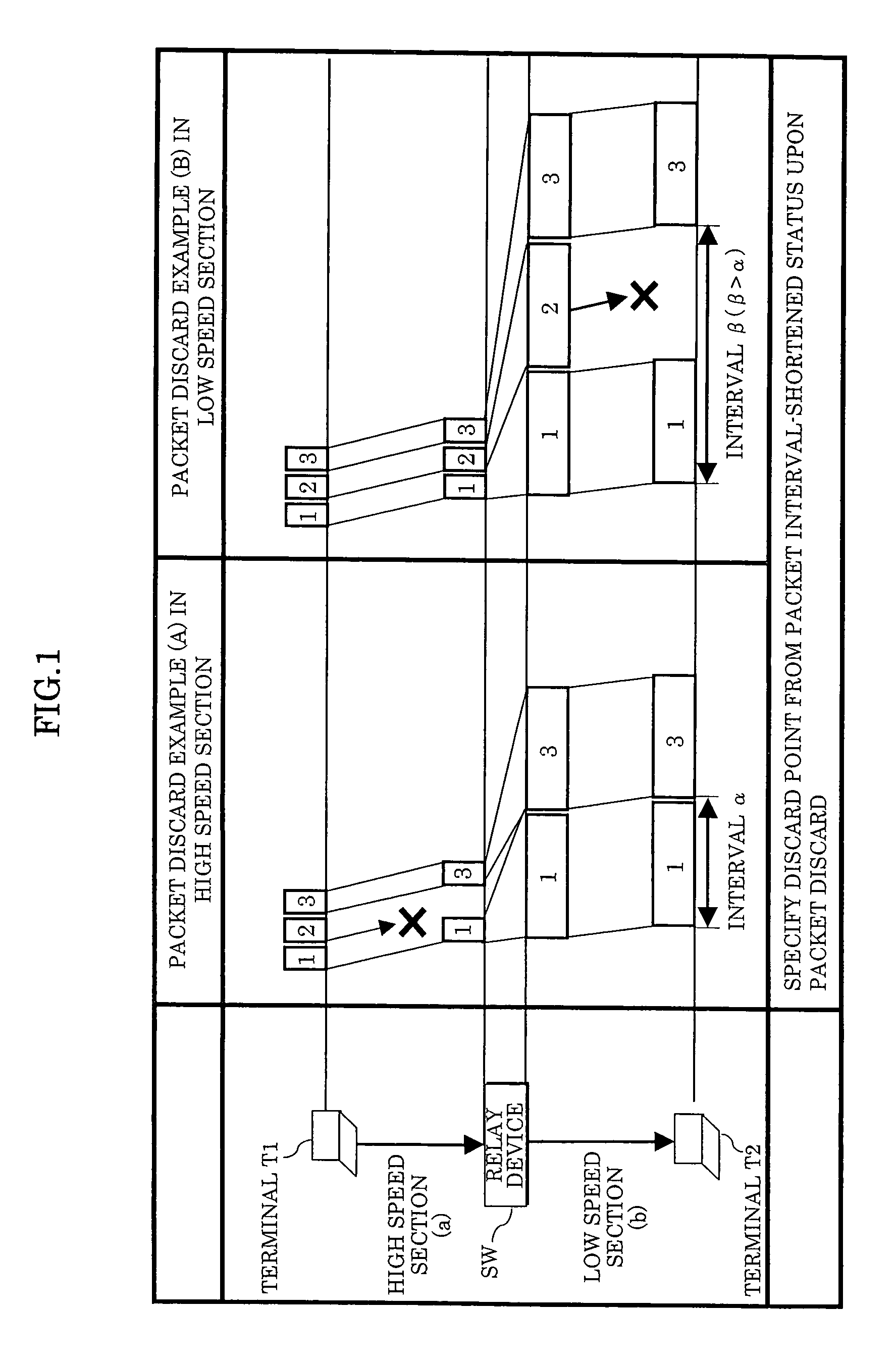Packet discard point probing method and device
a point probing and point-to-point technology, applied in the field of package discard point probing method and device, can solve the problems of high labor cost and temporal cost of setting, operating and measuring two devices, and the failure to recover, so as to reduce time, cost and labor.
- Summary
- Abstract
- Description
- Claims
- Application Information
AI Technical Summary
Benefits of technology
Problems solved by technology
Method used
Image
Examples
operational embodiment (1) (determination by sequential transmission of packets between two terminals : figs.5-8)
Operational Embodiment (1) (Determination by Sequential Transmission of Packets Between Two Terminals: FIGS. 5-8)
[0108]In this operational embodiment, the packet discard point probing is performed based on the fact that the packet interval is shortened only when the packet discard has occurred in the high speed section (1) upon sequentially transmitting the packets between the terminals T1 and T2.
[0109]FIG. 5 shows a packet sequence in a case where no packet discard has occurred. In the example of FIG. 5, the packets of sequence numbers 1-4 (hereinafter, occasionally described as packets 1-4) sequentially transmitted from the transmitting terminal T1 arrive at the receiving terminal T2 through the L2 switches SW1 and SW2 without being discarded. At the terminal T2, it can be detected that no packet discard has occurred since there is found no missing sequence number.
[0110]FIG. 6 shows a packet sequence in a case where the packet discard has occurred in the high speed section (1). In...
operational embodiment (2) (determination by sequential transmission of probing packets : figs.9-12)
Operational Embodiment (2) (Determination by Sequential Transmission of Probing Packets: FIGS. 9-12)
[0114]In this operational embodiment, the packet discard point probing is performed by noticing that the packet interval is shortened only when the probing packets are sequentially transmitted and the packet discard has occurred in the high speed section in the up direction. In this operational embodiment (2), both of the transmission processing and the packet discard point determination processing are performed at the transmitting terminal T1 shown in FIG. 4.
[0115]FIG. 9 shows a packet sequence in a case where no packet discard has occurred in the same way as the operational embodiment (1) of FIG. 5. As shown in FIG. 9, the packets 1-4 transmitted from the probing terminal T1 are transmitted to the probed terminal T2 through the L2 switches SW1 and SW2. The terminal T1 having received probing response packets 1-4 from the terminal T2 can recognize that no packet discard has occurred ...
operational embodiment (4) (determination by a large size probing packet : figs.17-20)
Operational Embodiment (4) (Determination by a Large Size Probing Packet: FIGS. 17-20)
[0125]In this operational embodiment, the packet discard point probing is performed by noticing that as for a probing packet (e.g. ping request / response packet of 15,000 bytes) having a size large enough to cause an IP fragment, the packet interval is shortened when the packet discard has occurred in the high speed section in the down direction, the packet interval is unshortened when the packet discard has occurred in the low speed section in the down direction, and the probing response itself is not returned when the packet discard has occurred in either high or low speed section in the up direction.
[0126]FIG. 17 shows a packet sequence in a case where no packet discard has occurred when a ping request packet Req divided into packets 1-4 is transmitted from the probing terminal T1 to the probed terminal T2. As shown in FIG. 17, all of the packets 1-4 are received at terminal T2 and the ping reque...
PUM
 Login to View More
Login to View More Abstract
Description
Claims
Application Information
 Login to View More
Login to View More - R&D
- Intellectual Property
- Life Sciences
- Materials
- Tech Scout
- Unparalleled Data Quality
- Higher Quality Content
- 60% Fewer Hallucinations
Browse by: Latest US Patents, China's latest patents, Technical Efficacy Thesaurus, Application Domain, Technology Topic, Popular Technical Reports.
© 2025 PatSnap. All rights reserved.Legal|Privacy policy|Modern Slavery Act Transparency Statement|Sitemap|About US| Contact US: help@patsnap.com



